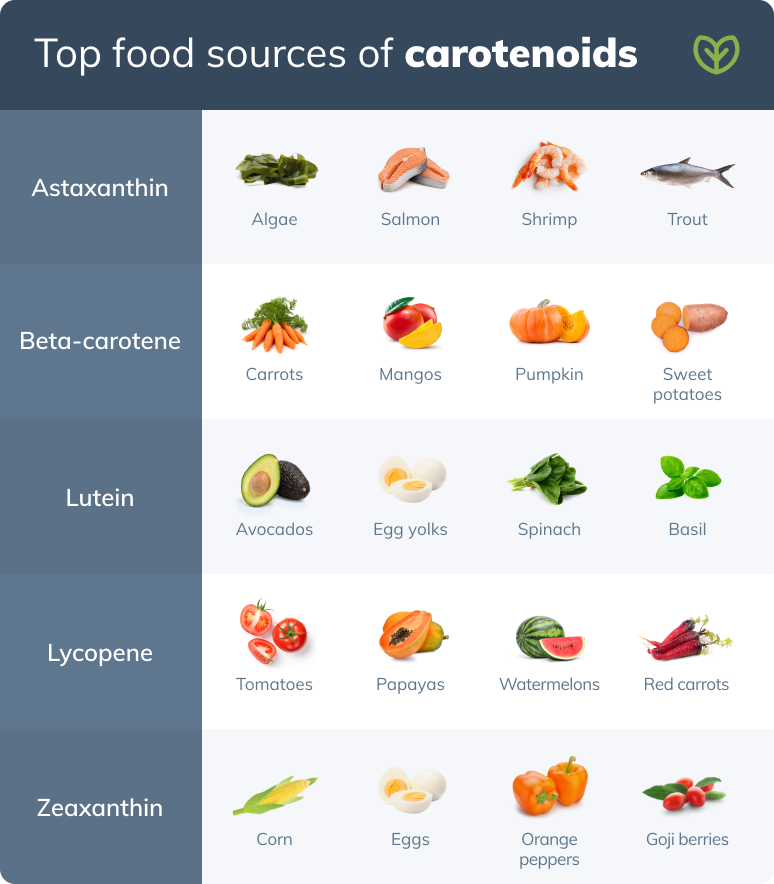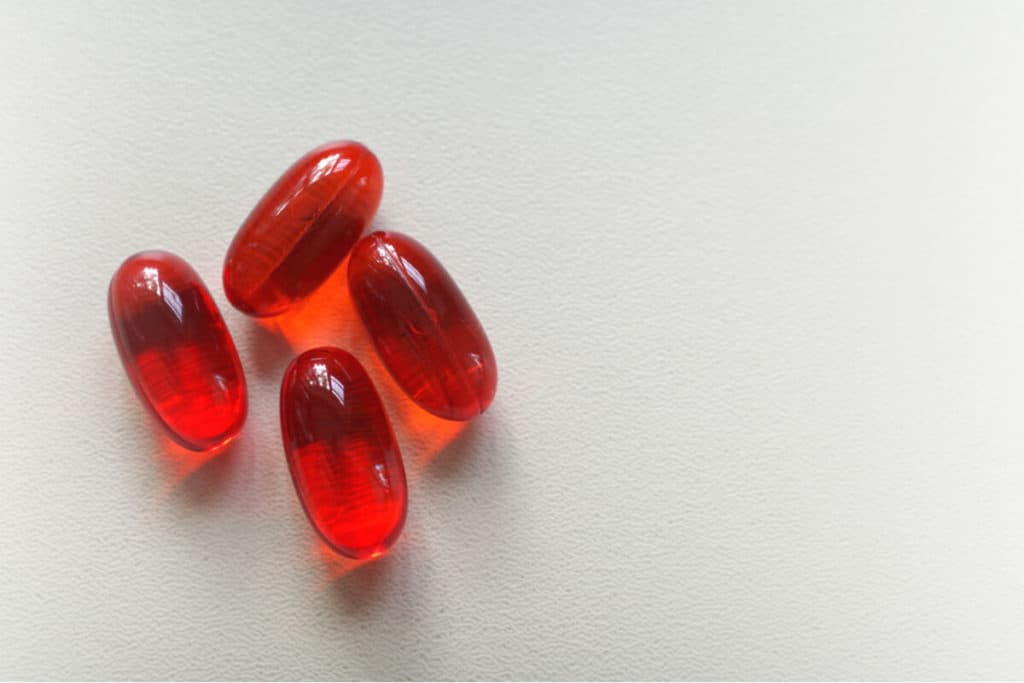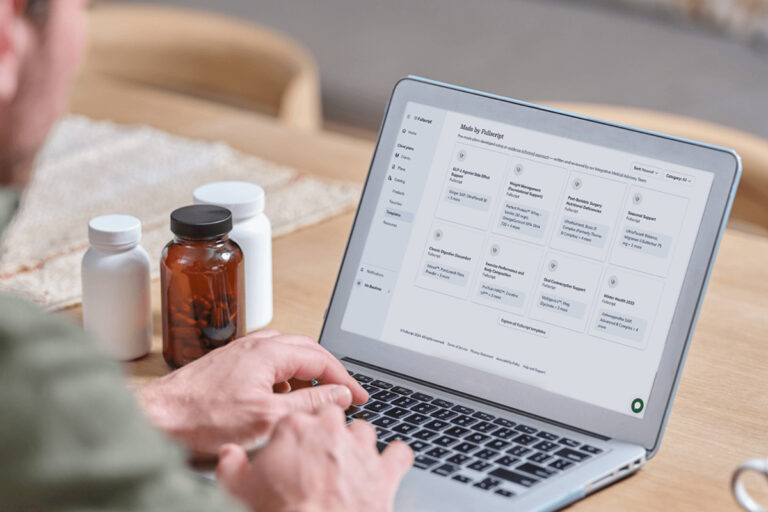
What are carotenoids?
Carotenoids are fat-soluble pigments produced by plants and microorganisms. (19) They offer a beautiful array of color in our world, and when we consume them through our diet, they pass along their antioxidant, anti-inflammatory, and neuroprotective abilities. (2) Carotenoids are typically divided into two groups: carotenes and xanthophylls. Carotenes, such as beta-carotene and lycopene, provide rich orange and red pigments. Beta-carotene, the most widely known carotene, is also known as a provitamin A as it gets converted to vitamin A in the body. As an essential nutrient, it is used to support immunity, reproduction, and eye health. (7) Xanthophylls, on the other hand, provide yellow pigments in nature and in our foods. Examples of well-known xanthophyll nutrients include lutein, zeaxanthin, and astaxanthin. (6) Even though our bodies don’t use these molecules to build vitamin A, they also act as antioxidants and are particularly beneficial for eye and brain health.Food sources of carotenoids
Since we cannot synthesize carotenoids on our own, we must consume them through a diet rich in fruits and vegetables. (2) Carotenoids can also accumulate in the tissues of animals, so foods like butter, egg yolks, and salmon are also excellent sources. (6)
Carotenoids can be found in many foods; some of the top dietary sources are summarized above. (1)(17)
Did you know? Heating and cooking lycopene-rich foods (e.g., tomatoes cooked into tomato sauce) actually increases bioavailability and absorption in the body. (16)
Top 3 benefits of carotenoids for brain health
Carotenoids are fat-soluble molecules, (6) contributing antioxidant and anti-inflammatory benefits to areas of the body rich in fatty tissue, including the eyes, skin, immune system, brain, and nervous system. (8)Of the over 700 types of carotenoids, (20) five are given special consideration in the realm of brain health and neuroprotection: astaxanthin, beta-carotene, lutein, lycopene, and zeaxanthin. Given their ability to protect tissues from oxidative stress, they play an important role in preventing neurological diseases and improving cognition. (2)Did you know? As lipid-soluble molecules, carotenoids are best absorbed when eaten with sources of healthy dietary fats such as olive oil. (16)
Memory support
Alzheimer’s disease (AD) is one of the most researched neurodegenerative diseases, impacting memory and quality of life. Growing evidence suggests that neuroinflammation is one of the main pathological features of AD contributing to memory loss. Carotenoids are receiving attention for their anti-inflammatory benefits (2) and the role they play in slowing the progression of dementia. (15) In some cases, higher antioxidant levels have been associated with a reduced risk of death from AD. (15) Low concentrations of beta-carotene, lutein, and vitamin A have been documented in several studies examining the blood nutrient levels of patients with AD. (2) In a 2008 study, the concentrations of beta-carotene, lutein, lycopene, and zeaxanthin were found to be significantly lower in patients with AD compared to a control group. (19) Researchers have linked higher carotenoid levels with a protective role against cognitive decline. Astaxanthin is of special interest as it can cross the blood-brain barrier. (4) One human study found that supplementing with 6 or 12 mg per day of astaxanthin had a strong antioxidant effect against dementia after 12 weeks of treatment. (11) Another human study involving 91 healthy individuals suggested that 12 months of supplementation with lutein (10 mg per day) and zeaxanthin (2 mg per day) improved memory compared to the placebo control group. (3)
Cognition
Cognitive disorders can affect several mental abilities, such as learning, problem solving, memory, and perception. (4) Consuming a colorful diet high in antioxidants has been shown to benefit cognitive function. A 2013 study testing processing speed, attention, and executive function in older subjects (aged 80 years and older) found that those with higher serum concentrations of lutein, zeaxanthin, and beta-carotene consistently performed better on given tasks. (13) Lutein and zeaxanthin are especially associated with better recall and verbal fluency, according to a 2018 article examining the health effects of dietary carotenoids. Since lutein and zeaxanthin mainly accumulate in the brain, it is important to consume these and other key brain health nutrients regularly to keep cognitive levels sharp. According to the 2011 to 2014 National Health and Nutrition Examination Survey involving over 2,000 participants aged 60 years and older, lutein and zeaxanthin supplementation at 2.02 mg per day may prevent cognitive decline. (15)Did you know? Infants can receive lutein through breast milk. Recent studies have begun to examine the beneficial effects of lutein in growing children through improved cognition, memory, environmental perception, and even academic performance. (10)
Mood and depression
Since carotenoids are potent antioxidants and anti-inflammatory agents, they provide support to the nervous system through protection from free radicals, DNA damage, (2) and inflammation. Lycopene, the carotene present in tomatoes, has been shown to reduce neuroinflammation and depression-like behaviour in mice. (2) A study of middle-aged people (aged 20 to 60 years) with generalized anxiety disorder also found that supplementing with antioxidants, specifically beta-carotene, for six weeks reduced anxiety and depression scores. (5) An additional Italian study of older adults (women and men aged 65 and older) assessed the likelihood of depressive symptoms in relation to their blood carotenoid levels. The results showed that low levels of carotenoids were associated with depressive symptoms and even predicted the development of new symptoms in older persons. (9)How to select the right carotenoid supplements
Even though we can consume a variety of carotenoids in our diet through foods like carrots, pumpkin, salmon, tomatoes, and egg yolks, additional supplementation may be indicated in certain circumstances.
Did you know? Long-term excessive beta-carotene supplementation may lead to carotenodermia, a harmless condition in which the skin becomes yellow-orange in colour. This condition can be easily reversed by discontinuing supplementation (12)
The bottom line
A diet rich in colorful fruits and vegetables will provide a wealth of carotenoid nutrients, contributing antioxidant and anti-inflammatory benefits. Combining healthy whole foods and practitioner-approved supplementation in your wellness plan may be ideal to reap the full benefits of carotenoids for brain and overall health.- Abdel-Aal, E.M., Akhtar, H., Zaheer, K., & Ali, R. (2013). Dietary Sources of Lutein and Zeaxanthin Carotenoids and Their Role in Eye Health. Nutrients, 5(4), 1169-1185. https://doi.org/10.3390/nu5041169
- Cho, K. S., Shin, M., Kim, S., & Lee, S. B. (2018). Recent Advances in Studies on the Therapeutic Potential of Dietary Carotenoids in Neurodegenerative Diseases. Oxidative Medicine and Cellular Longevity. 2018(4120458). https://doi.org/10.1155/2018/4120458
- Crowe-White, K. M., Phillips, T. A., & Ellis, A. C. (2019). Lycopene and cognitive function. Journal of nutritional science, 8(20). https://doi.org/10.1017/jns.2019.16
- Galasso, C., Orefice, I., Pellone, P., Cirino, P., Miele, R., Ianora, A., Brunet, C., & Sansone, C. (2018). On the Neuroprotective Role of Astaxanthin: New Perspectives?. Marine Drugs, 16(8), 247. https://doi.org/10.3390/md16080247
- Gautam, M., Agrawal, M., Gautam, M., Sharma, P., Gautam, A. S., & Gautam, S. (2012). Role of antioxidants in generalised anxiety disorder and depression. Indian Journal of Psychiatry, 54(3), 244–247. https://doi.org/10.4103/0019-5545.102424
- Green, A. S., & Fascetti, A. J. (2016). Meeting the Vitamin A Requirement: The Efficacy and Importance of β-Carotene in Animal Species. The Scientific World Journal, 2016(7393620). https://doi.org/10.1155/2016/7393620
- Grune, T., Lietz, G., Palou, A., Ross, A. C., Stahl, W., Tang, G., Thurnham, D., Yin, S. A., & Biesalski, H. K. (2010). Beta-carotene is an important vitamin A source for humans. The Journal of Nutrition, 140(12), 2268S–2285S. https://doi.org/10.3945/jn.109.119024
- Hubler, M. J., & Kennedy, A. J. (2016). Role of lipids in the metabolism and activation of immune cells. The Journal of Nutritional Biochemistry, 34, 1–7. https://doi.org/10.1016/j.jnutbio.2015.11.002
- Milaneschi, Y., Bandinelli, S., Penninx, B.W., Corsi, A.M., Lauretani, F., Vazzana, R., Semba, R.D. et al. (2012). The relationship between plasma carotenoids and depressive symptoms in older persons. The World Journal of Biological Psychiatry. 13(8). 588-598. https://doi.org/10.3109/15622975.2011.597876
- Moran, N. E., Mohn, E. S., Hason, N., Erdman, J. W., Jr, & Johnson, E. J. (2018). Intrinsic and Extrinsic Factors Impacting Absorption, Metabolism, and Health Effects of Dietary Carotenoids. Advances in Nutrition, 9(4), 465–492. https://doi.org/10.1093/advances/nmy025
- Nakagawa, K., Kiko, T., Miyazawa, T., Carpentero Burdeos, G., Kimura, F., Satoh, A., & Miyazawa, T. (2011). Antioxidant effect of astaxanthin on phospholipid peroxidation in human erythrocytes. The British Journal of Nutrition, 105(11), 1563–1571. https://doi.org/10.1017/S0007114510005398
- National Institute of Health. (2020, February). Vitamin A Fact Sheet for Professionals. https://ods.od.nih.gov/factsheets/VitaminA-HealthProfessional/
- Nouchi, R., Suiko, T., Kimura, E., Takenaka, H., Murakoshi, M., Uchiyama, A., Aono, M., & Kawashima, R. (2020). Effects of Lutein and Astaxanthin Intake on the Improvement of Cognitive Functions among Healthy Adults: A Systematic Review of Randomized Controlled Trials. Nutrients, 12(3), 617. https://doi.org/10.3390/nu12030617
- Schagen, S. K., Zampeli, V. A., Makrantonaki, E., & Zouboulis, C. C. (2012). Discovering the link between nutrition and skin aging. Dermato-endocrinology, 4(3), 298–307. https://doi.org/10.4161/derm.22876
- Tan, B. L., & Norhaizan, M. E. (2019). Carotenoids: How Effective Are They to Prevent Age-Related Diseases?. Molecules, 24(9), 1801. https://doi.org/10.3390/molecules24091801
- Toti, E., Chen, C. O., Palmery, M., Villaño Valencia, D., & Peluso, I. (2018). Non-Provitamin A and Provitamin A Carotenoids as Immunomodulators: Recommended Dietary Allowance, Therapeutic Index, or Personalized Nutrition?. Oxidative Medicine and Cellular Longevity, 2018 (4637861). https://doi.org/10.1155/2018/4637861
- Tudor, C., & Pintea, A. A Brief Overview of Dietary Zeaxanthin Occurrence and Bioaccessibility. (2020)..Molecules, 25(18), 4067; https://doi.org/10.3390/molecules25184067
- Valadon, L. R., & Mummery, R. S. (1968). Carotenoids in floral parts of a narcissus, a daffodil and a tulip. The Biochemical Journal, 106(2), 479–484. https://doi.org/10.1042/bj1060479
- Wang, W., Shinto, L., Connor, W. E., & Quinn, J. F. (2008). Nutritional biomarkers in Alzheimer’s disease: the association between carotenoids, n-3 fatty acids, and dementia severity. Journal of Alzheimer’s Disease, 13(1), 31–38. https://doi.org/10.3233/jad-2008-13103
- Zielińska, M. A., Wesołowska, A., Pawlus, B., & Hamułka, J. (2017). Health Effects of Carotenoids during Pregnancy and Lactation. Nutrients, 9(8), 838. https://doi.org/10.3390/nu9080838





